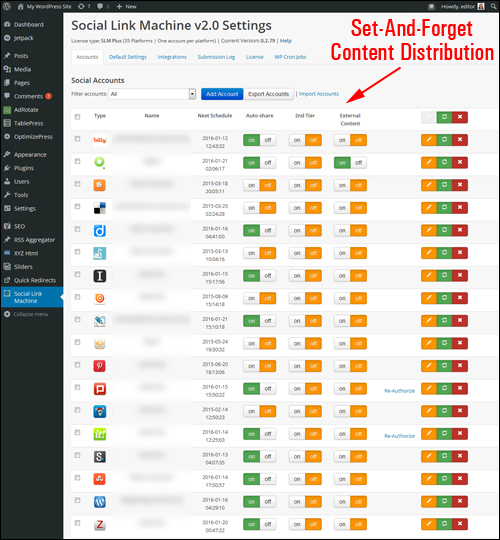 Welcome to Part 4 of our Website Traffic Blueprint article series, where we show you how to automate traffic to your site using the WordPress CMS platform.
Welcome to Part 4 of our Website Traffic Blueprint article series, where we show you how to automate traffic to your site using the WordPress CMS platform.
So far, we have covered the following in this article series:
In Part 1 of this article series, we describe the traffic automation process, and explain why using an expertly configured WordPress website is the key to automating traffic to your website …
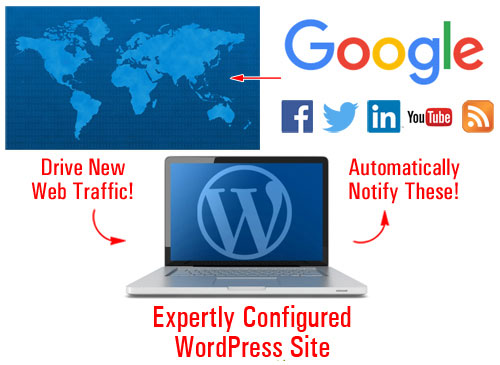
(With an expertly configured WordPress site, all you have to do is post great content on a consistent basis to automatically attract more web traffic!)
In Part 2, we focused on the setup phase. We explained the best way to start if you don’t have a website yet, how to set things up if you already have a site, and what to do if your existing website has been built using WordPress.
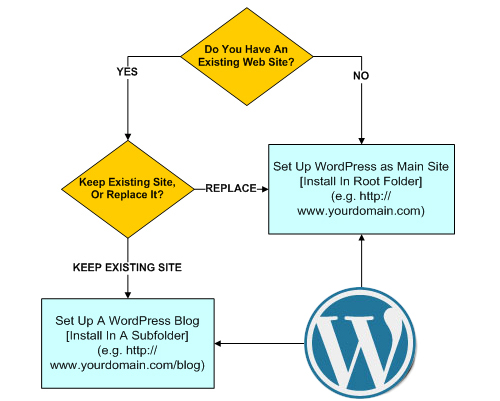
(In Part two we show you where to set up WordPress on your domain)
In Part 3, we discussed the configuration phase of the traffic automation system.
In this step, we configure hosting settings, internal settings, and external settings that can affect your site’s traffic-getting ability …
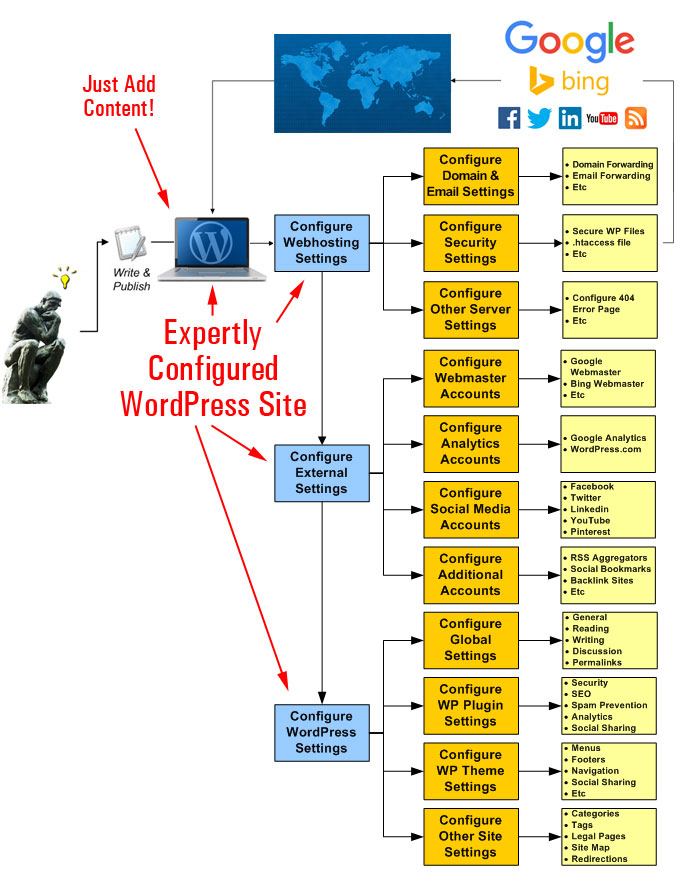
(In Part 3 you will configure hosting settings, internal settings, and external settings that can affect your website’s ability to generate traffic automatically)
In Part Four, we will discuss ways to automate the traffic-generation process using plugins.
Why It Makes Sense To Automate Your Traffic-Getting Process
Depending on which marketing gurus you talk to, you could find yourself spending 1-2 hours or more every day promoting your business on social media.
Most businesses simply lack the time, human resources and budget to employ the services of a full-time marketing department and engage in the kind of content marketing that many online marketing experts recommend doing. If you were to spend most of your time posting updates on Twitter, LinkedIn, and Facebook in addition to writing content for your blog or website, how would you get anything else in your business done?
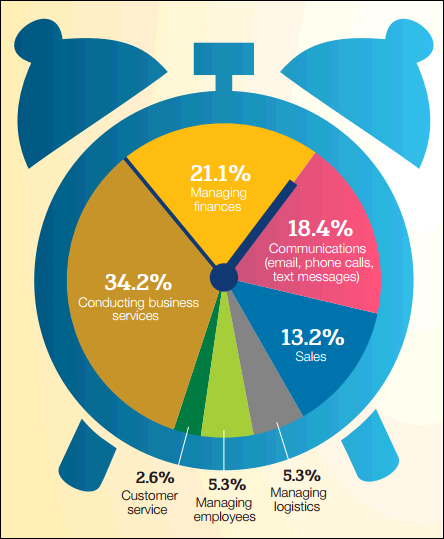
(Small businesses spend most of their working hours keeping their businesses up and running. Image source: NFIB)
Many business owners spend most of their working hours simply keeping their businesses up and running. On top of this, there’s also sales and marketing. After all, businesses need to stay competitive and grow in order to survive.
A study of small businesses done in 2012 by email and social media marketing company Vertical Response found that:
- Almost half of all small businesses surveyed spent at least six hours per week on social media (most of the other businesses surveyed using social media spent even more time – between 6 and 21+ hours per week). This use of social media was a 66% increase from the previous year, so if the same survey was done today, the numbers would probably be higher.
- More than half of all businesses surveyed spent 1-3 hours or more creating a blog post.
- Finding and posting content for social media was the activity that consumed the most time online for all businesses surveyed.
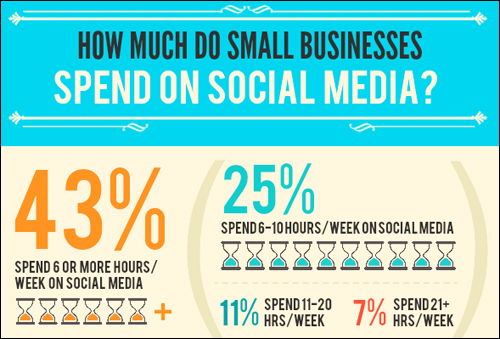
(Small businesses spend more time every year marketing and promoting themselves online. Source: VerticalResponse)
As small businesses spend increasingly larger amounts of time promoting and marketing themselves online in order to compete and survive, this leaves less time for under-resourced businesses to focus on other equally vital areas …

(Businesses with limited resources, time, and marketing budget and many different business areas to focus on require careful planning of their marketing strategy.)
Another important thing to keep in mind is that, in addition to spending time marketing and promoting your business on various social media websites, you are investing all of your efforts into virtual real estate that you don’t control. You don’t own Facebook, Twitter, or StumbleUpon. These companies can and will make decisions that can dramatically impact your business without requiring your input. Why invest so much effort and time building content on someone else’s asset? With WordPress, you can control your own real estate and post your content automatically to other sites.
Automating processes to save time and increase productivity is nothing new. Businesses have been doing it since the Industrial Age. In the Digital Age, however, the exponential growth channels for marketing and promoting a business online creates a number of dilemmas for business owners and marketing managers, especially for those with limited time, budgets, and resources. For example:
- Which marketing channels should you focus more of your efforts, budget, and your time on?
- Should you invest so much time and effort building assets on sites that you do not own (e.g. Facebook, Twitter, Pinterest, etc.) while ignoring your own domain?
- Do you create new content for every channel you plan to promote and market your business on?
The Benefits Of Automating The Traffic-Getting Process With WordPress
What I’d like to show you now, is a free, simple, and effective formula that lets you automate the traffic generation process with WordPress.
With this strategy, you will be able to:
- Save time creating content for your website or blog and other marketing channels (e.g. social media),
- Save money on content creation and unnecessary online marketing channels,
- Determine which channels you should focus more of your efforts, budget, and time on,
- Invest most of your efforts building your own asset instead of someone else’s and still benefit from other people’s marketing channels.
![]()
Many automated web traffic solutions tend to focus on black hat methods, such as manipulating search engine results. This is not what the focus of this article series is about. In fact, we recommend staying away from all black hat methods, tools, websites, and anything designed to “game” or violate the terms of service and policies of sites like Pinterest, Facebook, Google.

(Web traffic automation does not have to involve the use of black hat methods!)
The purpose of this series of articles is not to game online services or flaunt their terms of service, but to show you how to be smart with your resources and automate your content distribution in order to leverage your time and efforts, and increase your exposure online to websites that your target audience frequents.
An Automated Content Distribution, Traffic And Lead Generation, And Sales & Marketing System
We’ve just seen in the previous section that most businesses lack the time, resources and financial means to engage in the kind of content marketing that most experts advise doing. What you want to do, then, is be strategic with your limited time, resources, and budget.
So, instead of posting content to services individually, which is extremely time-consuming …

(Posting content to different channels is very time-consuming!)
Why not choose this method instead …
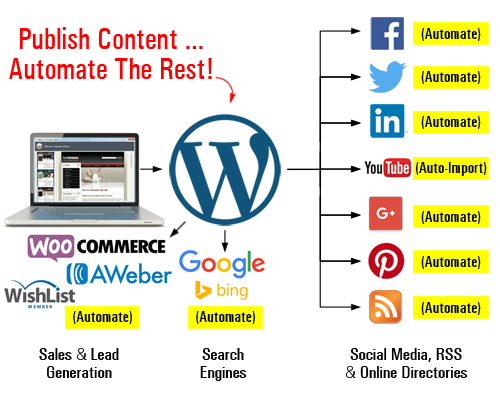
(Set up an automated content distribution, lead and traffic generation, and sales and marketing system with WordPress)
With an expertly configured WordPress site, you can build more than just a website for your business … you can set up an automated traffic and lead generation and sales & marketing system, where all you do is publish your content and WordPress then automates the rest.
With WordPress, you can publish content once, and automate the distribution of your content to all other services.
You can:
- Automatically distribute content to social media sites and bookmarking sites,
- Automatically distribute comments and content to other blogs and online properties using RSS
- Automatically import content (e.g. videos)
As your business evolves, you can add more functionality and automate processes like:
- Sell products and services with e-commerce,
- Capture leads with opt-in forms and add your subscribers to newsletters and autoresponders,
- Allow visitors to register on your site with different membership levels,
- And so much more!
You can do all of this using inexpensive WordPress plugins. Once these plugins are installed and configured on your site, just direct your visitors to the appropriate sections (e.g. your store, subscription forms, membership area, etc.)
How do you do all of this?
Simple … first, set up your site as shown in Part 2. Then, get it all configured as described in Part Three. After all this is in place, you then automate your content distribution with plugins.
The video below shows you how everything works once your WordPress site has been expertly configured …
WordPress Web Traffic System – Traffic Plugins
Let’s take a brief look at some examples of traffic-generating WordPress plugins that can help to:
- Post content automatically to social sites and social bookmarking websites
- Post comments automatically to other blogs
- Post content automatically via RSS to other sites
Jetpack
You can get your posts automatically distributed to sites like Facebook, Twitter, Tumblr, LinkedIn, GooglePlus and more as soon as you publish new content using a WordPress plugin like JetPack.
Download URL: https://jetpack.com/
Jetpack is a free WordPress plugin with loads of useful functions.
After installing Jetpack, you will need to connect the plugin to the WordPress.com account you set up in Part Three …
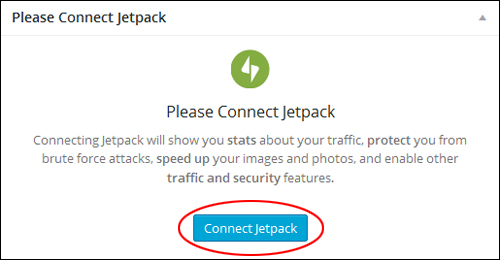
(Make sure that Jetpack is connected to your WordPress.com account)
Next, activate a feature called Publicize …
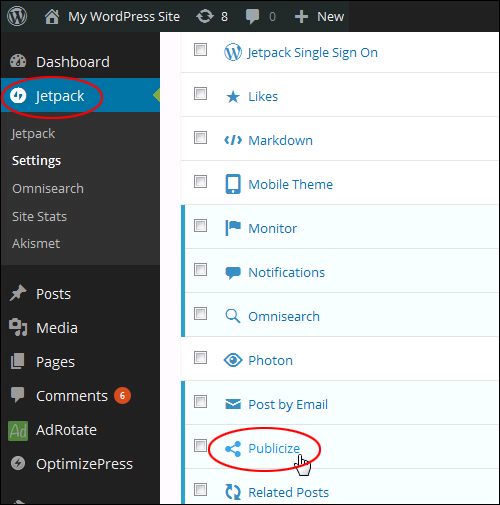
(Activate the Publicize feature on Jetpack)
Once this section is configured, you will be able to automatically share your posts on Twitter, Tumblr, Facebook, LinkedIn, Google+, and more …

(Distribute your content to various social networks.)
After all account and plugin settings have been configured, your content is ready for distribution.
Publicize adds a new section to your Publish box …
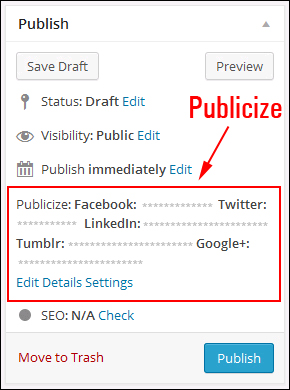
(Publicize settings in your Publish section.)
Now, whenever you publish new content, it will automatically be shared on all of the accounts you have set up …
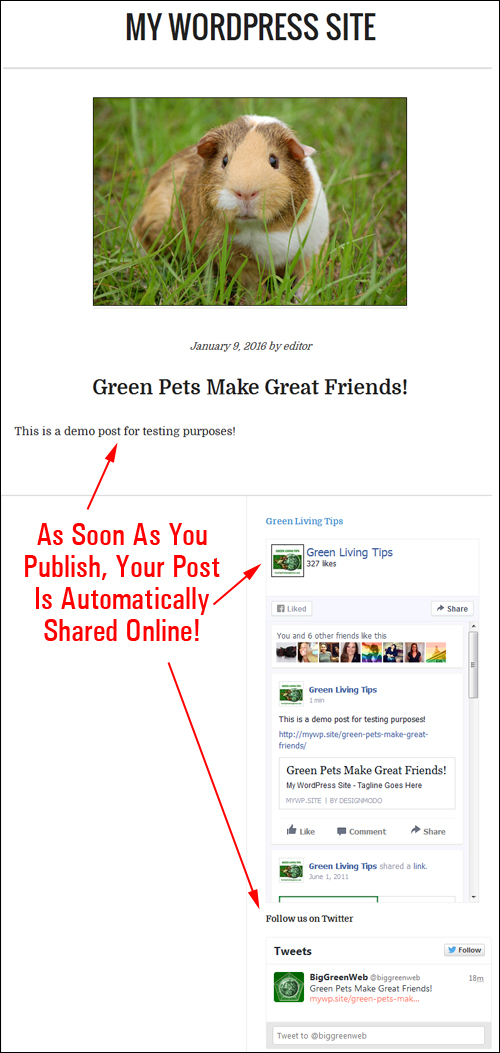
(As soon as content is published, it is automatically shared online.)
For more details about the benefits of this WordPress plugin, go here: Jetpack
CommentLuv
(CommentLuv)
WordPress has a native commenting feature that allows your site users to engage with your website or blog, post comments, reply to other users and engage with your content as part of an online community.
You can enhance the WordPress built-in commenting feature with a number of 3rd-party plugins like Disqus, IntenseDebate, LiveFyre, or CommentLuv that integrate your comments with social media, helping to spread and share your content online.
For example, using a WordPress plugin like CommentLuv (Pro version) can help make your site more attractive to commenters by offering them a choice of backlinks if they +1, like, or tweet your post. This plugin will visit the website or blog of the comment author while they enter their comment and retrieve their last blog posts, which can be included below their comment when they click the submit button.
(CommentLuv can attract more comments and improve user engagement on your website or blog.)
To learn more about this WordPress plugin, visit the plugin website:
Social Link Machine
(Social LinkMachine – Set-and-forget content distribution plugin for WordPress)
Social Link Machine is a plugin for WordPress that allows you to automatically syndicate and drip-feed your content to over 30 authority sites, build anchor text backlinks, include relevant videos and images, and create social signals on auto-pilot …
(SocialLinkMachine – syndicate content to many online sites)
With SocialLinkMachine installed, you can automatically syndicate and drip-feed your content to over 30 authority websites, such as:
- Bookmarking Sites: e.g. Deviantart, Diigo, Instapaper, Reddit, etc.
- Blogs: e.g. Blogger, Rebel Mouse, Tumblr, etc.
- Social Platforms: Facebook, YouTube, etc.
- Image Sharing Platforms: e.g. Flickr, etc.
- PDF Sharing Platforms: e.g. Docdroid, Scribd, etc.
Visit the plugin website to learn more about the benefits of using this plugin: SocialLinkMachine
Also, if you would like to know more about setting up social media monitoring (in order to get actionable information about your content marketing campaigns), we have written a comprehensive article about social media measurement tools and technologies that you may want to check out. Go here to learn more about this:
![]()
The above are just some examples of the many plugins that WordPress makes available for automating and syndicating the distribution of your content online.
Kickstart Your WordPress Traffic System
After your traffic automation system has been set up, we recommend kickstarting the process of driving traffic to your site with the steps shown in this tutorial:
WordPress Traffic Automation Blueprint: Content Syndication Process – Summary
Once your website and plugins have been expertly configured and fully set up, all you need to do then to start generating new traffic is post web content on a regular basis.
![]()
If you need great content ideas for your website, we recommend subscribing to our FREE email training series on content marketing here:
Once you have expertly configured your WordPress site, the next step is to optimize as much of the process as can be improved. This step is covered in the next section of our WordPress Traffic System series.
This is the end of Part 4
To read the rest of this article series, click here:

***
"This is an awesome training series. I have a pretty good understanding of WordPress already, but this is helping me to move somewhere from intermediate to advanced user!" - Kim Lednum
***





